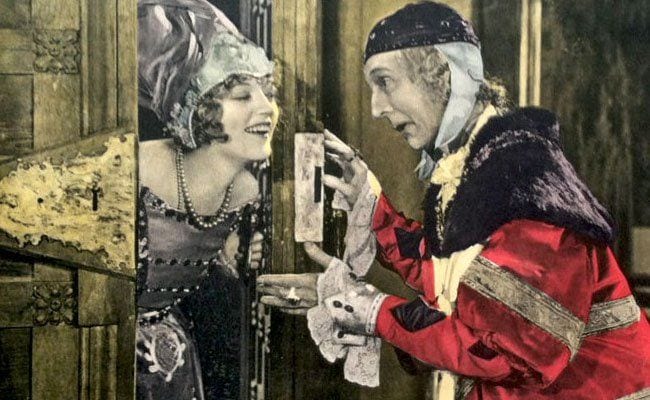Thanks to Kickstarter crowdfunding, Ben Model’s Undercrank Productions has released beautiful, newly scored prints of three Marion Davies movies from 1922.
Most film buffs are aware that Davies’ career was personally supervised by her paramour, newspaper tycoon William Randolph Hearst, whose Cosmopolitan Pictures spared no expense in lavish productions, matched by equally lavish (if free) publicity in Hearst papers. Her busy career is marked by a tension between Hearst’s desire to see her in idealized roles in serious dramas or costume pictures and her vivacious personality and obvious gift for comedy. These three examples show successful compromise. All three are comedies in the classical sense of ending in marriage, while one film has scenes of slapstick and social satire and another gives Davies chances to be burlesque and rambunctious.
The Bride’s Play is directed with lovely pictorial delicacy by George W. Terwilliger, a once busy gentleman about whom little seems known today. Set in Ireland but apparently shot on the California coast, the feather-light story from a Donn Byrne play follows a conveniently rich yet unspoiled heroine who temporarily yields her heart to the empty blandishments of a shallow womanizing poet (Carl Miller) instead of the dull solid local lord (Wyndham Standing) who waits in the wings. The tale would make more sense if we understood the poet to have physically seduced her, but the movie can’t go that far. Climactic suspense is generated for the wedding ritual in which the bride must reveal her true feelings, and this involves a historical flashback with Davies in a second role.
This film, like the other two, comes from a Library of Congress print in terrific shape, and the original tints have been restored. The result is a great-looking, detailed, fluid picture that casts a gentle spell for 75-minutes and has a satisfying ending.
The next film, Beauty’s Worth, is another handsome 75-minute special dripping with production value and again shot beautifully by Ira H. Morgan, although it offers no restored tints. The 20-something Davies plays another pure marriageable teen with money, this time identified as a Quaker, which here means dressing and acting like Puritans out of The Scarlet Letter. Her comical maiden aunts (Martha Mattox, Aileen Manning) are always having conniptions over her high spirits, but they permit her to vacation at a fashionable watering hole where her supposedly outmoded bathing suit covers no more than the modern one-piece skirt and tights worn by a modern rival.
Once again, the story’s moral has something to do with looking beyond the flashy shallow surface of things (though fortunately, everything does look great) to perceive true worth. While the bright young things condescend to the Quaker girl, one artist (Forrest Stanley) sees her real value and proves it to everyone with a makeover and a charade presentation of three elaborate tableaus he throws together at a moment’s notice. What an artist! These turn her into a spectacle with parallels to Hearst’s relentless showcasing of Davies, with the audience within the film overwhelmed and goggling. The tableaus give Model a chance to incorporate idiomatic sounds into his organ score.
While these are contemporary tales of modern values that strike a blow for the rich yet simple girl, When Knighthood Was in Flower is a fabulously expensive period piece (1.5 million bucks) set at the court of Henry VIII. Based on the bestseller by now-forgotten historical novelist Charles Major, it spins a yarn of Henry’s sister Mary Tudor (Davies). Henry (Lyn Harding) wants to marry her off to the aged Louis XII of France (William Norris) while she’s in love with dashing Captain Brandon (Forrest Stanley), and this leads to no end of complications amid staggering sets designed by architect Joseph Urban.
Young William Powell plays the chief villain, Louis’ lascivious nephew in tights. Although tights were menswear in that era, Mary dons them when she pretends to be a boy and gets to buckle some swash. At several points, she burlesques the material with coquettish scenes, and she shines during these moments more becomingly than when bewailing her fate. She was fully encouraged by prolific director Robert G. Vignola, who also helmed her irrepressible antics in Beauty’s Worth.
In this case, the efforts paid off, for When Knighthood Was in Flower turned out be hugely popular with critics and audiences of the day. Model has restored the original tinting, as he did with The Bride’s Play, and also restored the complicated hand-tinted colors of the flaming torches during a climactic sequence. His new organ score incorporates two tunes written by Victor Herbert for the picture.
Undercrank has issued When Knighthood Was in Flower in a Blu-ray/DVD dual package, while the other two films are DVD only. We’re glad Model found such excellent Library of Congress prints of these Paramount releases, and we encourage more such efforts in the future. There are still many Davies films unissued on video, not to mention a thousand other worthy movies.

